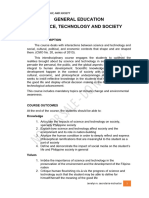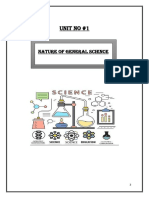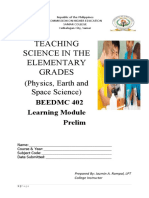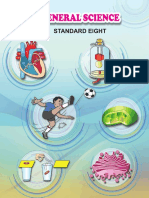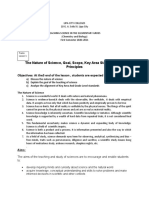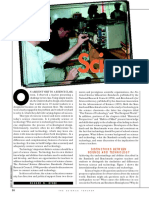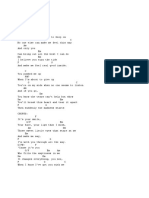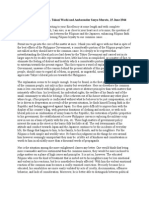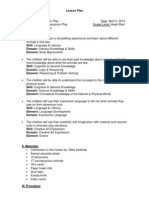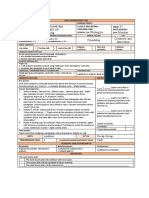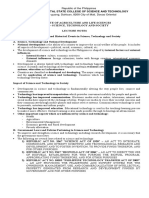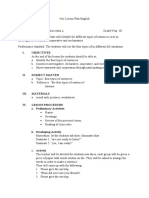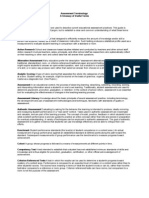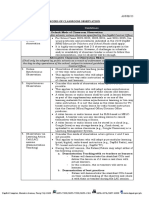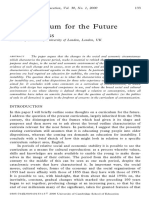Upload Browse Download
of 24
General Science Let 08
Ratings: 0|Views: 57|Likes: 1 Published by Jhemz Sabalza See More
GENERAL EDUCATIO N (20%
�Natural Sciences)
Content Update: Basic concepts and Principles
�Introduction:Sc ience is, indeed, one of the most important subject areas in
�todays curricu lum. Much emphasis have been to this field of study. Life has been increasinglyinfl
�uenced by science and technology in our pursuit of a more comfortable lifestyle. Techn
�ology is the application of the scientific theories and laws. The inventions intelecommuni
�cation and transportation have drawn the world smaller and smaller. Withthe advent of information
�can be relayed to other parts of the word in just a matter of seconds. The recent breakthroughs
�in genetic mapping have made it possible toidentity the useful and bad genes that will
�result to the breeding of a better specie.All these have made life more convenient
�than ever. However, these technologymay also pose hazard to mankind if not used properly.
�The mobile phones couldsabotage the economy of a particular country. The ever-increasing
�number of vehicleshas been badly changing our climatic condition.Scien ce can be a
�vehicle to inculcate values on the proper use of technologythat bring both advantages and
�disadvantages. The natural sciences review shall focus on the following objectives:1.U
�tilize scientific knowledge in the preservation of human life
�andconservatio n of the earths resources
relate scientific theories of actual
�happenings and natural and maninducedcalamit ies
utilized biological
�knowledge and theories in the improvement of the quality of life and
apply knowledge and
�theories of physical sciences in the improvement of life2.Apply scientific knowledge
�and principles for the improvement of humanresourc es and socio-
�economic development3. Identify problems and suggest solutions related to
�personal andcommunity health I.What is Science? It presents a systematized
�body of knowledge, structured but not rigid. Thecontents or facts of this knowledge are
�gathered through keen observation andrelentless experimentatio n whereby the ideas
�generated are also products of further investigations.S cience is not only a mere body of
�knowledge. It is a search for answers toquestions, or of solutions to problems, using the
�process skills of observing,infer ring, experimenting, and the like.a.Natural
�Science is a wide field of study compressing biological and physicalscienc esb.Biological
�Sciences deals with life and has many branches. The two generalbranche s are botany
�(the study of plants) and zoology (the study of animals).c.Phy sical Sciences any of the
�natural sciences dealing with inanimate matter orwith energy as physics,
�chemistry, and astronomy collectively.Ge nerated knowledge or information through
�scientific study about livingand nonliving things and the process skills of science are
�used as tools orvehicles for addressing the needs and concerns of society.
�II.What is Technology? An applied science. It can be an invention, a gadget, a process or just
�an improved procedure. Tec hnology as a product may be a gadget, tool, device, piece of equipment,
�machine or instrument. Or may be a consumer item, such as seedlessgrapes, powered mild
�biodegradable soap and Styrofoam. The process of reproducing whole plants from its issue
�or plant tissue culture isan example of this kind of technology, so is skin grafting.
�St. Louis Review Center, Inc-Davao Tel. no. (082) 2242515 or 222-8732
1
Powder technology involves the
�making of dry materials with particle diametersof 100 micrometers (mm) or
�less.Powders are converted from bulk solids using mechanical processes whichsubject
�the mumps too contact forces. The lumps break up into very much smallerparticle s, the size of
�which depends not only on the forces applied but also on thenature of the material.
III.
�Basic Goals of Science Education: The teaching of science at all levels (from elementary to
�secondaryto tertiary level) is carried on for three basic reasons:a)to prepare scholars in the
�discipline ( pure scientists)b)to provide individuals with a background
�in science of technological orprofessional occupations ( applied scientists)c)to provide
�individuals with a background science as part of their generaleducati on of effective
�citizenship ( the ordinary citizen)More specifically, the basic goal is to produce a populace
�withbasic understanding of the principles of science, the ability to utilize he
�technologyavai lable and an interest in and appreciation for science. ( THE DEVELOPME
�NT OF ASCIENTIFIC ALLY LITERATE CITIZENRY ). The identified
�constructs of Scientific and technological Literacy (STL) belowwere based on studies made
�by science educators and researchers using the followingbehav ior indicators:
A.
�Nature of Science and Technology - a teacher demonstrates anunderstandin g of the nature
�of science and technology when he/she:
-
exhibits knowledge of background on
�the history and development, thephilosophy, and the sociology of science and technology
appreciates the empirical nature and objectivity of science and technology
-
�recognizes the works of scientists and the nature of the scientificenter priseThe
�dimensions of the nature of science, based on the interdependentr elationship of process and
�products are:1 ) S c i e n c e proceeds as a series of approximati ons2 ) S c i e
�nce is tentative 3)Scientific knowledge is capable of public empirical
�test4)Scienc e proceeds on the assumption that time, space and matter
�arereal and that nature is consistent5 ) E very effect has a cause that can be q u a l i f i e d 6)
�There is no single method of science but many different possible
�waysof conducting investigations.
B.
Concepts and Principles o
�Science and Technology A teacherdemon strates knowledge of the basic
�concepts, principles of science andtechnology when he/she:
-
�defines an presents facts, basic concepts, principle and laws in sciencesand technology
applies science and technology concepts, principles and theories in reallife situations;
�i.e, in solving everyday problems and making decisions
-
�shows familiarity with the basic precepts of science and technology
-
�communicates effectively the scientific knowledge to bridge the gapbetween the scientific
�knowledge to bridge the gap between the scientificcomm unity and the lay public. The seven
�conceptual schemes are:1)All matter is composed of units called fundamental
�particles2)M atter can be classified in hierarchies or organization al
�levels.3)The behavior of matter in the universe can be described on a statisticalbasi
�s.4 ) U n i t s of matter interact
St. Louis Review Center, Inc-Davao Tel. no. (082) 2242515 or 222-8732
2
You're reading a free preview. Pages 3 to 24 are not shown in this preview.
�Activity (1)
Filters Add to collectionReviewAdd noteLikeEmbed
Nessa Santiago liked this|6 months ago More From This User
General Science Let 08 Jhemz Sabalza
cmo30s Jhemz Sabalza
3lp Jhemz Sabalza
Download and print this document
Read and print without ads Download to keep your version Edit, email or read offline
Choose a format:
.PDF .DOC
�Download About
About Scribd Team Blog Join our team! Contact Us
Subscriptions
Subscribe today Your subscription Gift cards
Advertise with us
Get started AdChoices
Support
Help FAQ Press Purchase Help
Partners
Publishers Developers / API
Legal
Terms Privacy Copyright
Get Scribd Mobile
Mobile Site
Copyright 2013 Scribd Inc. Language: English



